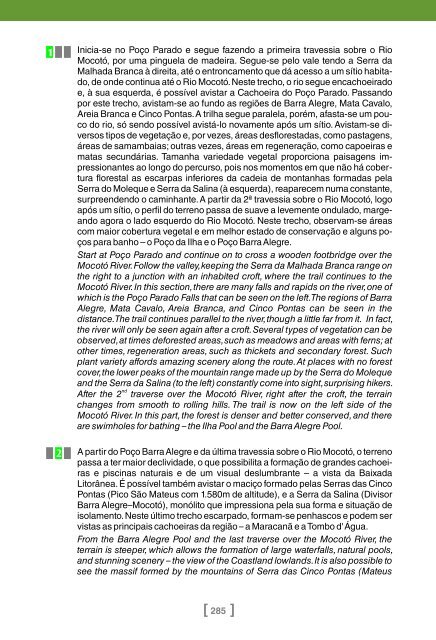Parque E - Senderos latinoamericanos
Parque E - Senderos latinoamericanos
Parque E - Senderos latinoamericanos
You also want an ePaper? Increase the reach of your titles
YUMPU automatically turns print PDFs into web optimized ePapers that Google loves.
Inicia-se no Poço Parado e segue fazendo a primeira travessia sobre o Rio<br />
Mocotó, por uma pinguela de madeira. Segue-se pelo vale tendo a Serra da<br />
Malhada Branca à direita, até o entroncamento que dá acesso a um sítio habitado,<br />
de onde continua até o Rio Mocotó. Neste trecho, o rio segue encachoeirado<br />
e, à sua esquerda, é possível avistar a Cachoeira do Poço Parado. Passando<br />
por este trecho, avistam-se ao fundo as regiões de Barra Alegre, Mata Cavalo,<br />
Areia Branca e Cinco Pontas. A trilha segue paralela, porém, afasta-se um pouco<br />
do rio, só sendo possível avistá-lo novamente após um sítio. Avistam-se diversos<br />
tipos de vegetação e, por vezes, áreas desflorestadas, como pastagens,<br />
áreas de samambaias; outras vezes, áreas em regeneração, como capoeiras e<br />
matas secundárias. Tamanha variedade vegetal proporciona paisagens impressionantes<br />
ao longo do percurso, pois nos momentos em que não há cobertura<br />
florestal as escarpas inferiores da cadeia de montanhas formadas pela<br />
Serra do Moleque e Serra da Salina (à esquerda), reaparecem numa constante,<br />
surpreendendo o caminhante. A partir da 2ª travessia sobre o Rio Mocotó, logo<br />
após um sítio, o perfil do terreno passa de suave a levemente ondulado, margeando<br />
agora o lado esquerdo do Rio Mocotó. Neste trecho, observam-se áreas<br />
com maior cobertura vegetal e em melhor estado de conservação e alguns poços<br />
para banho – o Poço da Ilha e o Poço Barra Alegre.<br />
Start at Poço Parado and continue on to cross a wooden footbridge over the<br />
Mocotó River. Follow the valley, keeping the Serra da Malhada Branca range on<br />
the right to a junction with an inhabited croft, where the trail continues to the<br />
Mocotó River. In this section, there are many falls and rapids on the river, one of<br />
which is the Poço Parado Falls that can be seen on the left. The regions of Barra<br />
Alegre, Mata Cavalo, Areia Branca, and Cinco Pontas can be seen in the<br />
distance. The trail continues parallel to the river, though a little far from it. In fact,<br />
the river will only be seen again after a croft. Several types of vegetation can be<br />
observed, at times deforested areas, such as meadows and areas with ferns; at<br />
other times, regeneration areas, such as thickets and secondary forest. Such<br />
plant variety affords amazing scenery along the route. At places with no forest<br />
cover, the lower peaks of the mountain range made up by the Serra do Moleque<br />
and the Serra da Salina (to the left) constantly come into sight, surprising hikers.<br />
nd<br />
After the 2 traverse over the Mocotó River, right after the croft, the terrain<br />
changes from smooth to rolling hills. The trail is now on the left side of the<br />
Mocotó River. In this part, the forest is denser and better conserved, and there<br />
are swimholes for bathing – the Ilha Pool and the Barra Alegre Pool.<br />
A partir do Poço Barra Alegre e da última travessia sobre o Rio Mocotó, o terreno<br />
passa a ter maior declividade, o que possibilita a formação de grandes cachoeiras<br />
e piscinas naturais e de um visual deslumbrante – a vista da Baixada<br />
Litorânea. É possível também avistar o maciço formado pelas Serras das Cinco<br />
Pontas (Pico São Mateus com 1.580m de altitude), e a Serra da Salina (Divisor<br />
Barra Alegre–Mocotó), monólito que impressiona pela sua forma e situação de<br />
isolamento. Neste último trecho escarpado, formam-se penhascos e podem ser<br />
vistas as principais cachoeiras da região – a Maracanã e a Tombo d' Água.<br />
From the Barra Alegre Pool and the last traverse over the Mocotó River, the<br />
terrain is steeper, which allows the formation of large waterfalls, natural pools,<br />
and stunning scenery – the view of the Coastland lowlands. It is also possible to<br />
see the massif formed by the mountains of Serra das Cinco Pontas (Mateus<br />
[ 285 ]


